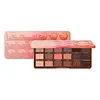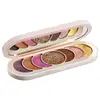What's inside
What's inside
 Key Ingredients
Key Ingredients

 Benefits
Benefits

 Concerns
Concerns

 Ingredients Side-by-side
Ingredients Side-by-side

Talc
AbrasiveMica
Cosmetic ColorantCaprylic/Capric Triglyceride
MaskingPtfe
Zinc Stearate
Cosmetic ColorantSodium Saccharin
MaskingWater
Skin ConditioningEthylene/Acrylic Acid Copolymer
Emulsion StabilisingGeraniol
PerfumingGlycerin
HumectantHexyl Cinnamal
PerfumingLimonene
PerfumingLinalool
PerfumingParfum
MaskingPhenoxyethanol
PreservativePrunus Persica Fruit Extract
AbrasiveSodium Dehydroacetate
PreservativeSorbic Acid
PreservativeCI 75470
Cosmetic ColorantUltramarines
Iron Oxides
CI 77742
Cosmetic ColorantCI 77891
Cosmetic ColorantCalcium Sodium Borosilicate
Silica
AbrasiveTin Oxide
AbrasiveCI 19140
Cosmetic ColorantCI 77491
Cosmetic ColorantBoron Nitride
AbsorbentCI 77510
Cosmetic ColorantCI 77163
Cosmetic ColorantCI 77400
Cosmetic ColorantBronzite Powder
Cosmetic ColorantCI 77499
Cosmetic ColorantTalc, Mica, Caprylic/Capric Triglyceride, Ptfe, Zinc Stearate, Sodium Saccharin, Water, Ethylene/Acrylic Acid Copolymer, Geraniol, Glycerin, Hexyl Cinnamal, Limonene, Linalool, Parfum, Phenoxyethanol, Prunus Persica Fruit Extract, Sodium Dehydroacetate, Sorbic Acid, CI 75470, Ultramarines, Iron Oxides, CI 77742, CI 77891, Calcium Sodium Borosilicate, Silica, Tin Oxide, CI 19140, CI 77491, Boron Nitride, CI 77510, CI 77163, CI 77400, Bronzite Powder, CI 77499
Calcium Sodium Borosilicate
Silica
AbrasiveCaprylyl Methicone
Skin ConditioningMica
Cosmetic ColorantDimethiconol
EmollientMagnesium Stearate
Cosmetic ColorantIsononyl Isononanoate
EmollientTrimethylsiloxysilicate
EmollientOctyldodecyl Stearoyl Stearate
EmollientGlyceryl Caprylate
EmollientPentylene Glycol
Skin ConditioningDimethicone
EmollientTin Oxide
AbrasiveMagnolia Officinalis Bark Extract
AntimicrobialWater
Skin ConditioningTalc
AbrasiveCaprylic/Capric Triglyceride
MaskingZinc Stearate
Cosmetic ColorantSodium Dehydroacetate
PreservativePhenoxyethanol
PreservativeAluminum Dimyristate
Emulsion StabilisingTriethoxycaprylylsilane
Disodium Stearoyl Glutamate
CleansingSorbic Acid
PreservativeEthylene/Acrylic Acid Copolymer
Emulsion StabilisingPoloxamer 338
EmulsifyingPolyethylene Terephthalate
Ricinus Communis Seed Oil
MaskingPolylactic Acid
AbrasivePolymethyl Methacrylate
Synthetic Fluorphlogopite
Polyurethane-11
Cocos Nucifera Oil
MaskingSynthetic Wax
AbrasiveMagnesium Myristate
Acrylates Copolymer
Lauroyl Lysine
Skin ConditioningTocopheryl Acetate
AntioxidantEthylhexylglycerin
Skin ConditioningCaesalpinia Sappan Bark Extract
Skin ConditioningIron Oxides
CI 77891
Cosmetic ColorantCI 77742
Cosmetic ColorantCI 77007
Cosmetic ColorantCI 16035
Cosmetic ColorantCI 19140
Cosmetic ColorantCI 77000
Cosmetic ColorantCI 42090
Cosmetic ColorantCalcium Sodium Borosilicate, Silica, Caprylyl Methicone, Mica, Dimethiconol, Magnesium Stearate, Isononyl Isononanoate, Trimethylsiloxysilicate, Octyldodecyl Stearoyl Stearate, Glyceryl Caprylate, Pentylene Glycol, Dimethicone, Tin Oxide, Magnolia Officinalis Bark Extract, Water, Talc, Caprylic/Capric Triglyceride, Zinc Stearate, Sodium Dehydroacetate, Phenoxyethanol, Aluminum Dimyristate, Triethoxycaprylylsilane, Disodium Stearoyl Glutamate, Sorbic Acid, Ethylene/Acrylic Acid Copolymer, Poloxamer 338, Polyethylene Terephthalate, Ricinus Communis Seed Oil, Polylactic Acid, Polymethyl Methacrylate, Synthetic Fluorphlogopite, Polyurethane-11, Cocos Nucifera Oil, Synthetic Wax, Magnesium Myristate, Acrylates Copolymer, Lauroyl Lysine, Tocopheryl Acetate, Ethylhexylglycerin, Caesalpinia Sappan Bark Extract, Iron Oxides, CI 77891, CI 77742, CI 77007, CI 16035, CI 19140, CI 77000, CI 42090
 Reviews
Reviews

Ingredients Explained
These ingredients are found in both products.
Ingredients higher up in an ingredient list are typically present in a larger amount.
Calcium Sodium Borosilicate is a bulking agent. It is considered a borosilicate glass; it is composed of powder or flakes of calcium and sodium borosilicates.
This ingredient is used to add volume, shine, and color to products. You'll most likely find this ingredient in makeup products.
According to in-vivo and ex-vivo studies done by a manufacturer, this ingredient works well with UV filters:
Learn more about Calcium Sodium BorosilicateThis ingredient is an emollient, solvent, and texture enhancer. It is considered a skin-softener by helping the skin prevent moisture loss.
It helps thicken a product's formula and makes it easier to spread by dissolving clumping compounds.
Caprylic Triglyceride is made by combining glycerin with coconut oil, forming a clear liquid.
While there is an assumption Caprylic Triglyceride can clog pores due to it being derived from coconut oil, there is no research supporting this.
Learn more about Caprylic/Capric TriglycerideCI 19140 is also known as Tartrazine. Tartrazine is a synthetic dye used in cosmetics, foods, and medicine to add a yellow color.
Tartrazine is created from petroleum and is water-soluble.
Some people may experience allergies from this dye, especially asthmatics and those with an aspirin intolerance.
Learn more about CI 19140This ingredient is used to add a violet color to cosmetics.
It is created by reacting phosphoric acid, ammonium dihydrogen orthophosphate, and manganese dioxide.
Ci 77891 is a white pigment from Titanium dioxide. It is naturally found in minerals such as rutile and ilmenite.
It's main function is to add a white color to cosmetics. It can also be mixed with other colors to create different shades.
Ci 77891 is commonly found in sunscreens due to its ability to block UV rays.
Learn more about CI 77891We don't have a description for Ethylene/Acrylic Acid Copolymer yet.
Mica is a naturally occurring mineral used to add shimmer and color in cosmetics. It can also help improve the texture of a product or give it an opaque, white/silver color.
Serecite is the name for very fine but ragged grains of mica.
This ingredient is often coated with metal oxides like titanium dioxide. Trace amounts of heavy metals may be found in mica, but these metals are not harmful in our personal products.
Mica has been used since prehistoric times throughout the world. Ancient Egyptian, Indian, Greek, Roman, Aztec, and Chinese civilizations have used mica.
Learn more about MicaPhenoxyethanol is a preservative that has germicide, antimicrobial, and aromatic properties. Studies show that phenoxyethanol can prevent microbial growth. By itself, it has a scent that is similar to that of a rose.
It's often used in formulations along with Caprylyl Glycol to preserve the shelf life of products.
Silica, also known as silicon dioxide, is a naturally occurring mineral. It is used as a fine, spherical, and porous powder in cosmetics.
Though it has exfoliant properties, the function of silica varies depending on the product.
The unique structure of silica enhances the spreadability and adds smoothness, making it a great texture enhancer.
It is also used as an active carrier, emulsifier, and mattifier due to its ability to absorb excess oil.
In some products, tiny microneedles called spicules are made from silica or hydrolyzed sponge. When you rub them in, they lightly polish away dead skin layers and enhance the penetration of active ingredients.
Learn more about SilicaThis ingredient is a preservative with antimicrobial properties. It is the sodium salt of dehydroacetic acid.
It is especially effective at preventing bacterial and fungal growth in low concentrations.
Sorbic Acid is a preservative. It is the most commonly used food preservative in the world.
Sorbic Acid is a natural antibiotic and highly effective at preventing the growth of fungus. It is less effective against bacteria.
Potassium Sorbate, another commonly-used preservative, is the potassium salt of Sorbic Acid.
Sorbic Acid may worsen eczema. We recommend speaking with a professional if you have any concerns.
Potassium sorbate and sorbic acid can be found in baked goods, cheeses, dried meats, dried fruit, ice cream, pickles, wine, yogurt, and more.
Learn more about Sorbic AcidTalc is a clay mineral. It helps absorb moisture and improve the texture of products. Like other types of clay, Talc can have a slight exfoliating effect on skin. Talc can be added to increase the volume of products.
Some Baby powders are made by combining talc with corn starch. The word "talc" comes from Latin and originates from Arabic. Talc is a mineral commonly found throughout the world.
If you have any concerns about using talc, we recommend checking out the FDA's official page.
Learn more about TalcTin Oxide is an inorganic oxide used to add opacity and volume to a product. In nature, it is already found in mineral form. The main ore of tin is an opaque and shiny mineral called casseterite.
Tin Oxide helps remove translucency in a product, or make it more opaque. Besides adding opacity, tin oxide is used for bulking to add volume.
Water. It's the most common cosmetic ingredient of all. You'll usually see it at the top of ingredient lists, meaning that it makes up the largest part of the product.
So why is it so popular? Water most often acts as a solvent - this means that it helps dissolve other ingredients into the formulation.
You'll also recognize water as that liquid we all need to stay alive. If you see this, drink a glass of water. Stay hydrated!
Learn more about WaterZinc Stearate is the metal salt of stearic acid. It is a white solid used to bind, thicken, and lubricate products.
This ingredient is common in powder makeup, where it helps keep the powder together.
Zinc Stearate is hydrophobic and repels water.
This ingredient can be sourced from non-animal or animal sources. It is best to reach out to the brand to see where they source this ingredient from.
Learn more about Zinc StearateThis ingredient is a combination of red, black, and yellow iron oxide pigments. This combination of colors is usually found in foundation, because it results in a "skin" color.